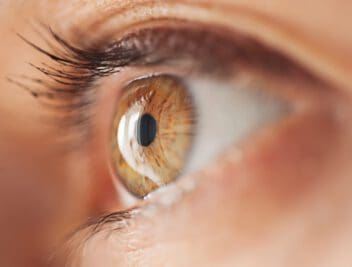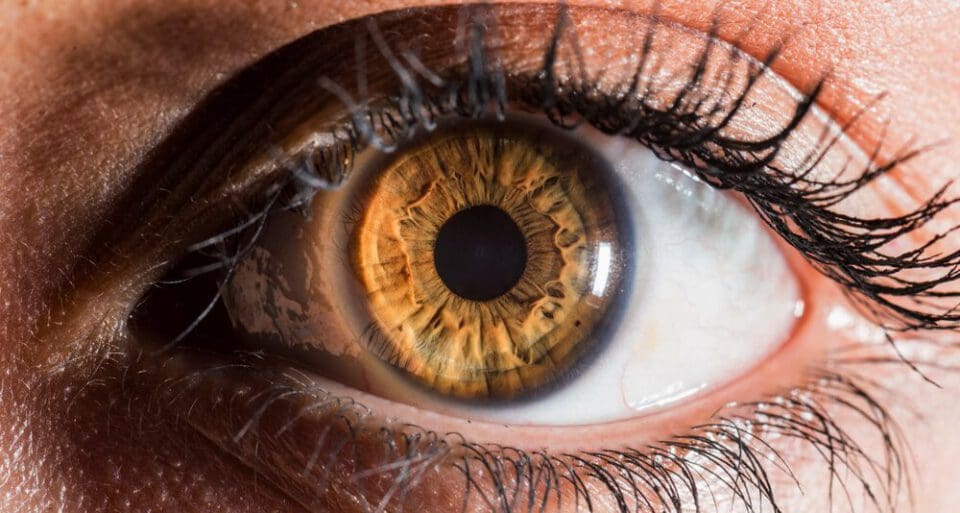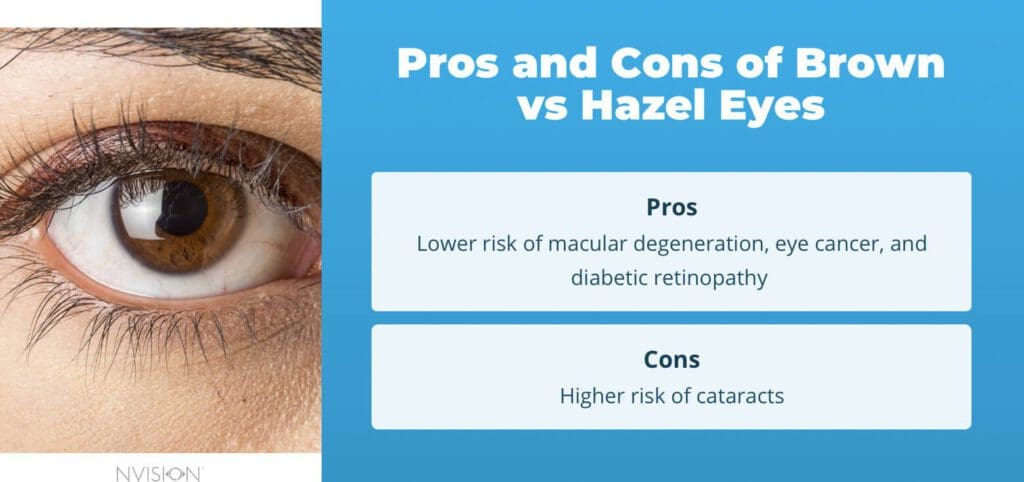Brown Eyes and Hazel Eyes: Why Are They Different?
Home / Vision Education Center /
Last Updated:
Across all the eye colors of humanity, it is estimated that 79% of people have brown eyes and only 5% have hazel eyes. While most people might regard the difference between brown and hazel eyes as trivial, they are two distinct hues with their own characteristics.
The ring of color around your pupil is called the “iris,” and it’s the part that determines eye colors. What color your irises have is determined by genetics.
While both brown and hazel eyes are considered “part of the brown family,” and hazel eyes even appear light brown under the right lighting conditions, hazel eyes actually have additional pigmentation due to melanin. Along with that, melanin plays a role in determining the darkness of your eye color. As a general rule, the more melanin, the darker the iris shade.
Table of Contents
Hazel vs. Brown Eyes: Differences and Similarities

Although we might categorize hazel eyes as being just a lighter shade of brown eyes, there are crucial differences.
Differences:
- Color Composition: The color composition is the most striking difference in hazel eyes as opposed to brown eyes. What we call “hazel” is actually a combination of pigments such as brown, amber, and green. Sometimes hazel eyes even have specks of other colors such as gray, blue, or gold. Conversely, brown eyes have a solid brown appearance with only slight tones of green or other colors.
- Variation and Complexity: Brown eyes have a more uniform and consistent color. Hazel eyes show far more variation and complexity in color and can change their appearance in different lighting.
- Genetics: Brown eyes are the most common color worldwide, suggesting a pronounced genetic identification. The less-common hazel eyes exhibit a mixture of a diverse color spectrum, suggesting a more complex genetic makeup.
You deserve clear vision. We can help.
With 135+ locations and over 2.5 million procedures performed, our board-certified eye surgeons deliver results you can trust. Your journey to better vision starts here.
Similarities:
- Pigmentation: Both brown and hazel eyes have brown pigment, in various levels of saturation.
- Appearance of rings and flecks: Hazel eyes most frequently exhibit flecks of other color, or have fluctuating rings, coronas, bands, or other designs. Brown eyes can have this as well, but the effect is far less common in brown eyes.
- Perception variation: Naturally, both hazel and brown eyes can appear to change hue based on lighting. But the perception of hazel eyes as changing color under different light levels is more dramatic.
- Uniqueness: To the naked eye, two brown-eyed people may seem to have identical eye color, but in fact we all have unique eye patterns just as with fingerprints. No set of hazel or brown eyes is exactly identical to another, even in twins.
When we truly examine the design and pigmentation of the human eye, we experience a deep appreciation for the diversity and beauty for the eye spectrum.

The genes associated with eye color largely work in the transport, storage, and synthesis of melanin, which is the pigment that results in eye color. Two of the common genes determining melanin are HERC2 and OCA2.
Melanosomes are the cellular structures that synthesize and store melanin, driven by a substance called a “P protein” that works to mature melanin. The OCA2 gene produces this P protein. Since brown eyes have a lot of melanin, they have higher levels of P protein.
Meanwhile, the HERC2 gene works as a switch to turn the OCA2 gene on or off. With more activity from the OCA2 gene, irises appear darker.
These two genes are the most significant determinants of eye color. With that said, there are many more genes that add more variation of tint and saturation.
Conventional wisdom has it that one can predict eye color of any baby by looking at the eyes of the child’s parents, but genetic variations can sometimes produce unexpected results.
What Are the Unique Characteristics of Brown and Hazel Eyes?
Compared to other eye colors, brown and hazel eyes have unique aspects.
The iris of the eye is composed of layers. On the back layer, both these eye shades have a normal level of melanin. On the front layer, brown eyes have additional eumelanin, making them darker, while hazel eyes have a layer of pheomelanin, which produces a greenish tint.
Even though we speak of melanin as being a single factor, there are actually two basic shades of melanin associated with pigmentation. Eumelanin lends a brown or black color, while pheomelanin lends a range of tints from yellow to red. Several more varieties of melanin exist, but they don’t play into eye color.
One might ask, “then how do blue eyes and green eyes get their color?” Blue eyes actually have almost no melanin, and get their color from the same physics factors that make the sky appear blue. Green eyes have the same effect, but have some yellow tinting added by pheomelanin.
Myths About Brown and Hazel Eyes
Once upon a time, scientists believed that eye color was determined by a single gene. We now know that eye color is a factor determined by as many as 16 genes. Genes can be either dominant or recessive, sometimes skipping a generation only to impact a newly born baby with throwback genes inherited from the child’s grandparents.
Thus, your eye color can be different from either of your parents’ eye colors, thanks to the complex genetic data inherited from your grandparents and generations further back.
Bear in mind also that eye color has no apparent effect on eyesight by itself under normal conditions. The only exception is that different eye shades fare differently under conditions of brighter or dimmer lighting.
You deserve clear vision. We can help.
With 135+ locations and over 2.5 million procedures performed, our board-certified eye surgeons deliver results you can trust. Your journey to better vision starts here.
Pros and Cons of Brown and Hazel Eyes

While we may think of eye color as mere decoration, eye color is associated with an increase or decrease in the risk of certain eye issues.
When people have brown eyes, they tend to be at a lower risk for macular degeneration, eye cancer, and diabetic retinopathy. While the reason why is unclear, it is believed that a higher level of melanin provides brown eyes with greater protection.
Another possible benefit of hazel or brown eyes is that you may be less prone to damage from environmental noise. It is believed that the higher level of melanin may offer protective benefits for the brain’s nerves that may experience damage due to noise.
On the risk side, brown eyes may be at a higher risk for developing cataracts. One study found that the risk may be twice as high as people with other eye colors. Exactly why this happens was not explored by the study.
Brown Eyes and Hazel Eyes Under Different Lighting Conditions
We know that the color white reflects light, while black absorbs light. The same physics factors come into play with eye color related to different lighting conditions. Darker eye tints have an advantage under glaring light conditions, such as a bright sunny day or when driving at night looking into oncoming headlights.
People with brown eyes experience less discomfort when squinting into the sun, because darker irises reflect less light within the eye. Conversely, people with brown eyes also might need an extra second for their eyes to adjust to darkness when entering a dimly lit area.
People with hazel eyes experience more discomfort from glaring light, but their vision adjusts to dim lighting just that fraction of a second faster.
Eye Color Variations
Newly born babies often have a lighter eye tint than they will have when they are more mature. Hence the expression “baby blue eyes.” As a general rule of thumb, most people’s eye color is fully realized by the age of one, but some people’s irises keep developing their tint until age six.
Very rarely, people may have different colored irises in each eye, such as one brown and one blue. This condition is called heterochromia. Heterochromia may be caused by genetic mutation, but it may also result from an eye injury.
Another form of heterochromia is sectoral heterochromia, which causes different hues to appear in the same iris. For example, it is possible to have an iris that is half-green and half-hazel. This is also caused by either genetic factors or a history of illness or injury affecting the eye.
You deserve clear vision. We can help.
With 135+ locations and over 2.5 million procedures performed, our board-certified eye surgeons deliver results you can trust. Your journey to better vision starts here.
References
- Heterochromia (April 2024). American Academy of Ophthalmology.
- The World’s Population by Eye Color Percentages. World Atlas.
- Why Are Brown Eyes the Most Common? (August 2017). American Academy of Ophthalmology.
- Genotype-Phenotype Associations and Human Eye Color. (October 2010). Journal of Human Genetics.
- Iris Color and Cataract: The Blue Mountains Eye Study. (August 2000). American Journal of Ophthalmology.
- Eye Color Linked to Pain Tolerance in Pilot Study at Pitt. (July 2014). Pittsburgh Post-Gazette.
- Is Eye Color Determined by Genetics? (May 2015). Genetics Home Reference.
This content is for informational purposes only. It may have been reviewed by a licensed physician, but is not intended to serve as a substitute for professional medical advice. Always consult your healthcare provider with any health concerns. For more, read our Privacy Policy and Editorial Policy.